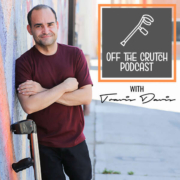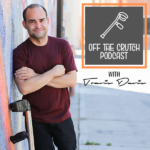CP and Me
It’s finally here! The first episode of Off The Crutch Podcast. This episode is all me. I’m spending 10 minutes with you sharing my background and talking about my disability, cerebral palsy. Enjoy!
Transcript
Kenny
Welcome to the Off The Crutch Podcast, your home for disability related topics from a disabled perspective. Enjoy the show.
Travis Davis
Before I begin, I want to give a shout out to my friend Kenny. He did the intro to this. I’m a firm believer of putting others before myself, which is why I wanted his voice to be the first person you heard before mine. So with that, welcome, everybody to the first episode of this podcast. I received great feedback from the trailer that I’m really appreciative of everybody who listened to that 45 second clip and subscribed.
But I’m gonna start with the question. What do you think is the most important thing in a relationship if you said anything other than trust That is the wrong answer. Trust drives everything whether you’re in a personal or professional relationship. So I look at this as a personal relationship we’re getting into. Because of that, I wanted to share a little bit about myself. I was born and raised here in Albuquerque, New Mexico. I got my bachelor’s degree in English from Azusa Pacific University, and I got my master’s and Adapted Physical Education from the University of New Mexico. I’ve worked for a couple nonprofits, but the majority of my time has been in education. I’m also a TEDx speaker, but we’re going to talk about that on a future episode. So what I’m about to say next, is a combination of what I’ve been told. From my doctors, my parents My own experiences. Though I was born prematurely. My due date was supposed to be in June. But my mom gave birth to me in April, April 22 is my birthday. So when I was born, the doctors saw that there was a lack of oxygen going to my brain. They needed a look at that. And they saw that there was some damage in my brain that was due to cerebral palsy. Later on, they discovered a heart murmur. And through some examination of that came to the conclusion that I had a hole in my heart. And this was happening right around the time that they saw that I had cerebral palsy. So I was in the hospital for a good six months off on getting that all worked on.
Along with that, they also discovered in my brain that there was an excess fluid going to it. And so they diagnosed me with hydrocephalus. And because of that they needed to put in what is called a shunt. And it’s like this tube is the catheter that goes inside your brain, all the way down to your stomach to regulate the brain fluid. So, I had all this happen within a span of six months. And I remember the last time that I saw my pediatrician, for the oldest that I could see him, he was telling me all of this, and he went, I was there with your leg doctor, your heart doctor and there are other Doctors there that just stopped operating on you because they didn’t think you were going to make it. It was a really rough experience that I must have gone through, obviously, I don’t remember any of it. So from birth to about 12 years old, I’ve had about 14 surgeries. And they ranged from my foot to duplicate surgeries they had to do on my legs to a shot replacement. I’m 32 years old now, and I’m happy to report that I don’t see doctors. And as far as I know, I’m 100% healthy as the episodes go along, I’ll continue to talk more and more about it. But right now, I want to shift and talk about cerebral palsy and the medical terms that are associated with with it. So what I have is called spastic diplegia. And within cerebral palsy there are four types there spastic dyskinetic, a toxic and mixed. A spastic is the most common type of cerebral palsy, spastic just for all of you that may not know means that the muscles are stiffer and tighter than normal. dyskinetic is a type of cerebral palsy where the muscle tone can suddenly change. So it can either be really tight or really floppy, which can cause uncontrolled involuntary movements, or muscle spasms. A toxic that’s the least common type of cerebral palsy. The movement is often shaky, and the balance can be poor in my balance is poor when I’m not using any type of support with the aid toxic muscle tones usually pretty floppy, and it can be difficult for somebody to have great posture to sit upright, and standing can be difficult. To attend those four types come another for the first one mana Puja, which affects one limb usually an arm hemiplegia, affecting one side of the body including an arm leg or trunk. diplegia, which is symmetrical parts of the body, either arms or legs, or quadriplegia, which affects all four limbs. There are instances where someone with cerebral palsy is non verbal. That’s something that I don’t think gets enough attention. But thankfully with assistive technology, those individuals who are non verbal are able to communicate either through iPads or other assistive technology. devices. According to the CDC, CP is the most common motor disability of childhood. About one in every 323 children are identified with CP. CP is more common among boys than girls. Over 50% of children who have CP can walk independently and most live to be over 100. I just made that stat up. The life expectancy is actually normal and not any different from somebody who doesn’t have cerebral palsy.
I don’t mind living with cerebral palsy. I think that it has given me many opportunities to talk with people about disabilities. I’ve done numerous talks at schools and given presentations and done a lot of advocacy work in my undergrad in graduate school. There’s also a lot of famous People with cerebral palsy. There’s RJ Mitte who was in Breaking Bad. Josh Blue, who’s a stand up comedian. He also won Last Comic Standing. I forget what season that was. And then there’s Zach Anner, who is on social media a lot. He has a book and he’s a pretty funny guy. I think anybody with a disability is considered famous. If Justin Bieber walked into a department store, he’d be instantly recognized and all eyes would be on him. I can’t even go into a target without being stared at. I don’t know of many celebrities who wait to get on a plane pre boarding anybody, but I don’t see many celebrities with that handicap placard. And now that I’m thinking about this out loud, I realized why so many people want to be my friend. I didn’t even mention Cutting the line at Disneyland or theme parks. In all seriousness, there are perks to having a disability. But there are also downsides. doctor’s appointments, surgeries, stigmas, discrimination ableism stares, I hope to cover all of this in my podcast. In the next few episodes, I’m going to continue sharing more about myself and an effort to continue building that trust with the wall. I have some great interviews with some friends, I want to dive a little deeper into my TEDx talk, which I’ll share with everybody. I want to end with this. I think the biggest thing that’s helped me throughout my life, living with a disability has been my support system, whether it’s my family, friends, teachers, so if anyone who’s listening who has a disability And is lacking that support system. Feel free to reach out to me through social media at off the crutch. I’m on Twitter, Instagram, Facebook. I’d love to connect with you and support you any way that I can. Well, that’s all I have for today. We made it 10 minutes. Thank you so much for your time. Please subscribe. Tell your friends and I look forward to having you back next week. Take care!
Transcribed by https://otter.ai


